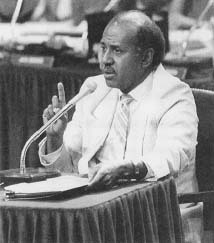Alcee Hastings Trial and Impeachment: 1983 & 1989
The Trial
Hastings lost his motion to remove the trial from Miami, but the presiding judge, Edward T. Gignoux, had come from the federal court in Maine because all the federal judges in the Southeast had disqualified themselves. Hastings, defying conventional wisdom that "a lawyer who defends himself has a fool for a client," chose to serve as co-counsel with Patricia Williams, who was also his fiancée. The government's opening argument compared the case to a "jigsaw puzzle where each piece is subject to debatable interpretation."
In fact, the case against Hastings was built almost entirely on circumstantial evidence. William Borders had already insisted that Hastings was not involved in his scheme, and refused to cooperate in any way, forcing the government to rely on tapes of phone calls between Hastings and Borders. The problem was that neither Romano's name nor any sum of money were ever mentioned, so the government had to argue that instead the two men had spoken in code. Thus, the government claimed that phone discussions about a "letter" for a certain Hemphill Pride was really referring to the court order to return $845,000 to Romano. The government also argued that Hastings' departure from Washington as soon as he got word of Borders' arrest constituted "flight" and suggested wrongdoing.
As his own defense lawyer, Hastings called on 49 witnesses—including his own mother—to counter the prosecution's case or to testify to his own integrity. Then, as the 50th witness, he took the stand for an entire day and effectively guided his inexperienced co-counsel, Patricia Williams, in his own interrogation. He had an explanation for each of the government's charges. The return of the $845,000: he did this because a recent appeals court ruling required it. Hemphill Pride was a real individual, a friend of his and Borders', and the letter was a real one that he considered writing to help get him reinstated to the bar. If his name was merely a code, Williams argued, "How would they distinguish when they were legitimately talking about Hemphill and about bribery?"
 Aylcee Hastings testifying during his Senate impeachment hearing.
Aylcee Hastings testifying during his Senate impeachment hearing.
In summing up, Hastings stated that Borders' claim to the FBI agent posing as Romano was an old lawyer's scam known as "rain-making." The lawyer takes the money to guarantee a decision that he already has reason to believe is coming down—and then if the decision goes otherwise, he returns the money with some excuse about the judge's running scared.
Whatever their reasoning, the jury—10 white people, two black-—after deliberating 17 and one-half hours over three days, returned with a verdict of not guilty. Hastings walked out of the court, still a federal judge. Indeed, on the courthouse steps, he stated, "I think I'm going to be a much better judge than I've ever been." Then he added a typically defiant punch line: "I don't think the Justice Department will ever be able to pull the wool over my eyes."
Additional topics
- Alcee Hastings Trial and Impeachment: 1983 1989 - Phase Two
- Alcee Hastings Trial and Impeachment: 1983 1989 - The Alleged Plot
- Other Free Encyclopedias
Law Library - American Law and Legal InformationNotable Trials and Court Cases - 1981 to 1988Alcee Hastings Trial and Impeachment: 1983 1989 - The Alleged Plot, The Trial, Phase Two, The Impeachment Trial, Hastings Rebounds